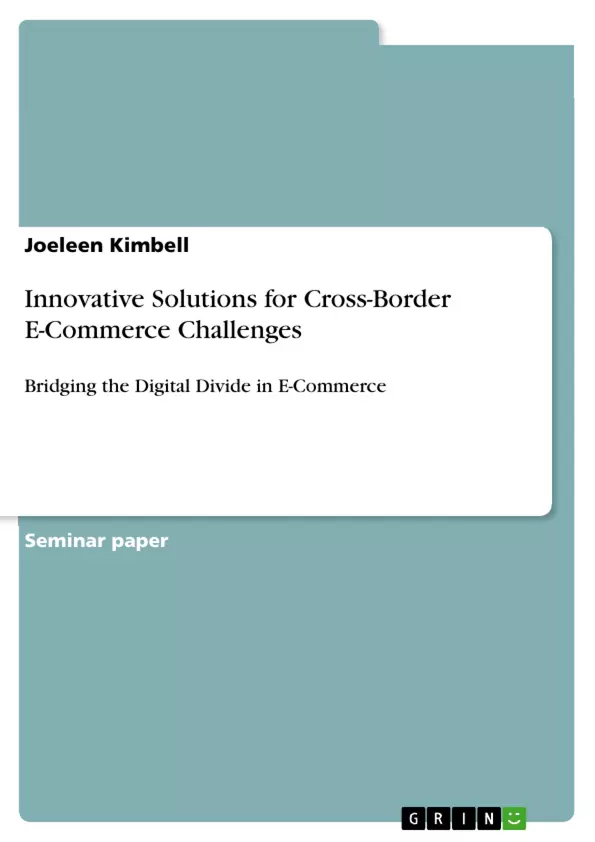This research study investigated the advancements in technology that aim at handling cross-border e-commerce barriers and the issue of the digital gap in e-business. E-businesses experience significant challenges encompassing cybersecurity, regulatory environments, physical structures, funding, culture, and customer-related factors. These challenges arise from differences in the level of technology, legal frameworks, and the extent of economic development. This paper explores the possible technological innovations related to cybersecurity, compliance, infrastructure development, financial technologies, and consumer engagement. Based on these findings, the research emphasizes convenient strategies that should be implemented to address the challenges of the digital marketplace and enhance the development of e-business.
Inhaltsverzeichnis (Table of Contents)
- CHAPTER ONE: INTRODUCTION
- 1.1 Background to the Study
- 1.2 Purpose of the study
- 1.3 Research Questions
- 1.4 Scope of the study
- CHAPTER TWO: LITERATURE REVIEW
- 2.1 E-Business Adoption
- 2.2 Challenges
- 2.3 How challenges differ in Regions
- 2.4 Technological solutions to overcome E-business challenges
- 2.5 Summary of Literature Review
- CHAPTER THREE: METHODOLOGY
- 3.1 Research Design
- 3.2 Data Collection
- 3.3 Target Population
- 3.4 Sample Size and Selection
- 3.5 Sampling Technique
- 3.6 Ensuring Representativeness
- 3.7 Addressing Potential Bias
- 3.8 Data Analysis
- 3.9 Ethical Considerations
- CHAPTER FOUR: FINDINGS AND DISCUSSION
- 4.1 Challenges Faced by E-Businesses
- 4.2 Regional and Market Differences
- 4.3 Technological Solutions to Address these Challenges
- 4.4 Implementation Strategies
Zielsetzung und Themenschwerpunkte (Objectives and Key Themes)
This research study investigates the challenges faced by e-businesses in cross-border e-commerce, focusing on the digital divide and technological solutions to overcome these barriers. The study explores technological innovations across various aspects of e-commerce, aiming to identify effective strategies for enhancing e-business development.
- Challenges of cross-border e-commerce
- Technological solutions for overcoming e-business challenges
- Regional differences in e-business adoption and challenges
- Strategies for bridging the digital divide in e-commerce
- Impact of technology on various aspects of e-business (cybersecurity, compliance, infrastructure, finance, and consumer engagement)
Zusammenfassung der Kapitel (Chapter Summaries)
Chapter One: Introduction provides background information on e-business, its impact on various business aspects, and its role in global markets. It also states the purpose, research questions, and scope of the study.
Chapter Two: Literature Review examines existing literature on e-business adoption, challenges faced by e-businesses, regional variations in these challenges, and existing technological solutions to overcome them.
Chapter Three: Methodology details the research design, data collection methods, target population, sample size and selection, sampling techniques, strategies for ensuring representativeness, addressing potential bias, data analysis methods, and ethical considerations.
Chapter Four: Findings and Discussion presents the findings of the study regarding the challenges faced by e-businesses, regional and market differences in these challenges, and technological solutions identified to address them. Implementation strategies are also discussed.
Schlüsselwörter (Keywords)
Cross-border e-commerce, digital divide, technological innovation, cybersecurity, regulatory compliance, e-business challenges, regional differences, implementation strategies, e-business development.
- Arbeit zitieren
- Joeleen Kimbell (Autor:in), 2024, Innovative Solutions for Cross-Border E-Commerce Challenges, München, GRIN Verlag, https://www.hausarbeiten.de/document/1516861


